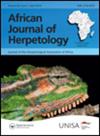An inventory of amphibian roadkill in the western Soutpansberg, Limpopo province, South Africa
IF 0.9
4区 生物学
Q3 ZOOLOGY
引用次数: 1
Abstract
ABSTRACT Increasing linear infrastructure development often impacts habitats and wildlife negatively. Roads, in particular, have numerous threats to wildlife with the most noticeable direct impact being roadkill, and this requires urgent conservation interventions. To assess amphibian roadkill, driven surveys were conducted on three regional roads around the western Soutpansberg in the Vhembe Biosphere Reserve, an important area for biodiversity conservation in South Africa. Six habitat types were identified along the monitored road stretches and their influence on the occurrence of amphibian roadkill was determined. The results comprised an inventory of 248 roadkill specimens, belonging to eight species and six families, and one unidentified specimen. Roadkill was strongly influenced by season, with the greatest roadkill rate recorded in the early wet season (0.051 roadkill km–1 day–1) compared to the late wet season (0.019 roadkill km–1 day–1). Amphibian roadkill patterns were related to roadside habitat. Of the roadside habitat types identified, road sections adjacent to waterbodies had the highest number of roadkill, followed by road sections closer to open savanna bushland. Roadkill frequency was low in areas that were partly located in human modified habitats (residential and agricultural areas) but highest in natural landscapes (near waterbodies and savanna bushland). The study provides baseline data that confirms the potential threat of roads and their users on the persistence of amphibians in the Vhembe Biosphere Reserve and presents the first systematic inventory of amphibian roadkill in the western Soutpansberg, South Africa.南非林波波省南潘斯堡西部被公路撞死的两栖动物清单
摘要日益增长的线性基础设施发展往往会对栖息地和野生动物产生负面影响。尤其是道路,对野生动物有许多威胁,其中最明显的直接影响是道路死亡,这需要紧急的保护干预措施。为了评估两栖动物的路杀情况,在Vhembe生物圈保护区的Soutpansberg西部周围的三条区域道路上进行了驾车调查,Vhembe是南非生物多样性保护的重要区域。在监测的道路沿线确定了六种栖息地类型,并确定了它们对两栖动物路杀事件发生的影响。研究结果包括248个路杀标本,属于8个物种和6个科,以及一个未鉴定的标本。路杀受到季节的强烈影响,与雨季后期(0.019公里-1天-1)相比,雨季早期(0.051公里-1天)的路杀率最高。两栖动物的路杀模式与路边栖息地有关。在已确定的路边栖息地类型中,靠近水体的路段的道路死亡人数最多,其次是靠近开阔草原灌木丛的路段。在部分位于人类改良栖息地(住宅区和农业区)的地区,路杀频率较低,但在自然景观(水体和稀树草原丛林附近)最高。该研究提供了基线数据,证实了道路及其使用者对Vhembe生物圈保护区两栖动物生存的潜在威胁,并首次对南非Soutpansberg西部的两栖动物道路死亡进行了系统调查。
本文章由计算机程序翻译,如有差异,请以英文原文为准。
求助全文
约1分钟内获得全文
求助全文
来源期刊

African Journal of Herpetology
ZOOLOGY-
CiteScore
3.00
自引率
6.70%
发文量
15
审稿时长
>12 weeks
期刊介绍:
African Journal of Herpetology (AJH) serves as an outlet for original research on the biology of African amphibians and reptiles. AJH is an interdisciplinary journal that publishes original articles and reviews from diverse fields and disciplines, such as conservation, phylogenetics, evolution, systematics, performance, physiology, ecology, behavioural ecology, ethology, and morphology.
The Journal publishes two issues a year. There are no page charges .
 求助内容:
求助内容: 应助结果提醒方式:
应助结果提醒方式:


